My Fantasia Festival, Days 12 through 14: Cybernatural, The House at the End of Time, and Time Lapse
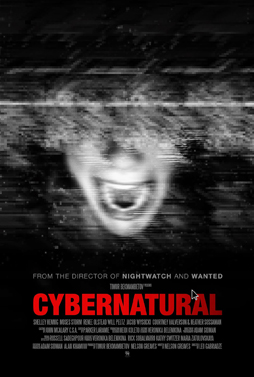 I didn’t see any films at Fantasia on Monday, July 28, and then on the 29th I saw two. One was Guardians of the Galaxy, which I’ve already written about. The next was a distinctive but disappointing horror film called Cybernatural. Disappointment here is perhaps relative; Cybernatural’s been one of the most talked-about films at the festival, so far as I can judge, and as a result my expectations were high. And honesty compels me to note that I’m not a big fan of horror movies as such, though I’d like to think I enjoy good horror when there’s a good story.
I didn’t see any films at Fantasia on Monday, July 28, and then on the 29th I saw two. One was Guardians of the Galaxy, which I’ve already written about. The next was a distinctive but disappointing horror film called Cybernatural. Disappointment here is perhaps relative; Cybernatural’s been one of the most talked-about films at the festival, so far as I can judge, and as a result my expectations were high. And honesty compels me to note that I’m not a big fan of horror movies as such, though I’d like to think I enjoy good horror when there’s a good story.
Certainly, the first film I’d see on Wednesday the 30th was a horror movie that erased the disappointment of the night before. The film that did the trick was Venezuela’s first-ever commercial genre film, The House at the End of Time (La casa del fin de los tiempos), which I followed with an American thriller called Time Lapse. It all made for an interesting mix of films.
Cybernatural was directed by Leo Gabriadze from a script by Nelson Greaves. Like Open Windows, it’s a movie that takes place entirely on a computer screen. In this case, the screen belongs to a teenaged girl named Blaire (Shelley Hennig), who at the start of the film is involved in a Skype chat with her boyfriend Mitch (Moses Jacob Storm). Things are about to get heated when suddenly more friends join, other kids at their school. But there’s somebody else with them, an anonymous presence on their group video chat. And their computers have started to act strange. It seems that exactly a year ago one of their former classmates committed suicide, after someone in the group posted a humiliating video of her online. Now she’s back for revenge.
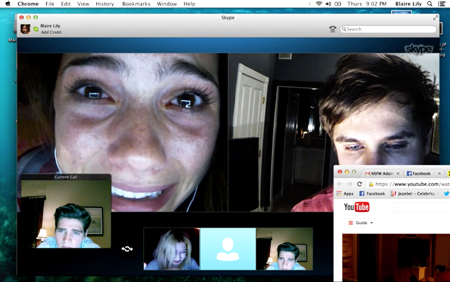 It’s an interesting idea, and the gimmick of sticking entirely with the image of Blaire’s computer screen is a good one. In the first half of the film, especially, the movie’s fidelity to this conceit plays brilliantly. We can see the tabs open in Blaire’s browser, we can see what she’s typing in an instant-message chat, and what she chooses to delete and retype. We see her hesitate before moving her mouse cursor. And we see familiar pages like Google and Facebook and Wikipedia start acting very strangely. When the Skype images freeze or break up there are moments of real tension as they slowly begin to resolve again, blurred images swirling pixels around.
It’s an interesting idea, and the gimmick of sticking entirely with the image of Blaire’s computer screen is a good one. In the first half of the film, especially, the movie’s fidelity to this conceit plays brilliantly. We can see the tabs open in Blaire’s browser, we can see what she’s typing in an instant-message chat, and what she chooses to delete and retype. We see her hesitate before moving her mouse cursor. And we see familiar pages like Google and Facebook and Wikipedia start acting very strangely. When the Skype images freeze or break up there are moments of real tension as they slowly begin to resolve again, blurred images swirling pixels around.
But very quickly problems arise. Things start to happen for no obvious reason. The characters stay on their computers when you think they’d try to shut them off; then when they do try, the monster seems to develop new powers to keep them from getting away. Sometimes the characters try to call for help, and have no luck. Other times they try and get further. Nobody comes to any of the teens’ rooms, no matter how loud they scream. Relatively early on there’s a good horror-movie incident when something jumps one of the characters, his camera cuts out, then we catch a glimpse of him sticking his hand in a high-speed blender. Then he’s dead. And you wonder: if the monster could possess him and make him shove his hand in a blender, why is it bothering to muck about on their computers?
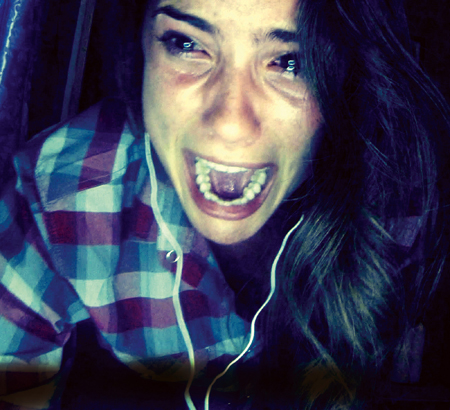 The acting’s fine. I thought that the young cast generally did a good job, especially when the script tried to pit the characters against each other. But as a group I felt they were underwritten. There seemed to be backstory missing; by the end of the movie the wrongdoings of two of the characters in the cyberbullying incident has become clear, but it’s vague how much and in what way the others were involved.
The acting’s fine. I thought that the young cast generally did a good job, especially when the script tried to pit the characters against each other. But as a group I felt they were underwritten. There seemed to be backstory missing; by the end of the movie the wrongdoings of two of the characters in the cyberbullying incident has become clear, but it’s vague how much and in what way the others were involved.
The film’s generally better at raising questions than answering them. One of the genuinely eerie elements in the film is the way the Wikipedia page for “Demonic Possession” keeps forcing its way to the front of Blaire’s desktop. And then at one point changes from the Roman alphabet to some other character set. The problem is that on the face of it there’s no demon mentioned anywhere else in the story. I tried to work out some way this could have been the tip-off of a hidden other plot (is Blaire’s name a reference to Linda Blair?) but couldn’t see anything. It comes off as a nice bit of atmosphere disconnected from anything else in the movie.
Fundamentally, my problem is that I didn’t see how the movie made sense. Maybe this is just me not being a horror fan, but I feel that whatever spooky powers a horror-movie monster has, whatever power it might have over the laws of physics, it has none over the power of drama. By the end of the story it should be possible to work out, at least in general terms, what the monster wanted, what its abilities were (and its limitations), and why it did the things it did at the points it did in order to get what it wanted. That’s true of Dracula, of Freddie Krueger, of the ghost in Ringu. Of course there can be ambiguity in all these things, but a general sense of why the monster’s going about its business in the way it is seems to me to be necessary. If it just develops power after power as needed, dramatic tension collapses; you’re watching a kind of diabolus ex machina, I suppose, knocking down targets at whim.
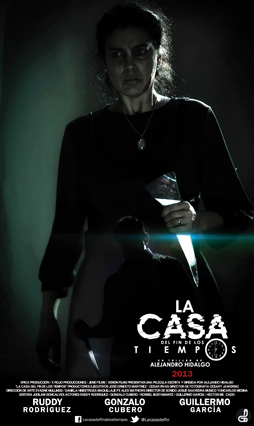 After watching Cybernatural I have no idea what the powers of the ghost are, or why it uses them when it does, or even precisely what it wants. If it can do all the things it seems to be able to do, there have to be easier and surer ways to murder a bunch of teenagers. And, again, if it can physically possess them, as it does once, why is it fiddling about on their computers? At first you think the film’s setting up questions it’ll go on to answer. But answers don’t come, and soon you realise it’s just about watching a bunch of kids die over a Skype call. I found it impossible to connect to the story. Even the occasional nice moment seems weirdly disconnected from the rest of the film; I’m thinking specifically of a death marked by the dismemberment of a Facebook page. It’s an odd animation about as over-the-top as something on South Park, and harder to take seriously.
After watching Cybernatural I have no idea what the powers of the ghost are, or why it uses them when it does, or even precisely what it wants. If it can do all the things it seems to be able to do, there have to be easier and surer ways to murder a bunch of teenagers. And, again, if it can physically possess them, as it does once, why is it fiddling about on their computers? At first you think the film’s setting up questions it’ll go on to answer. But answers don’t come, and soon you realise it’s just about watching a bunch of kids die over a Skype call. I found it impossible to connect to the story. Even the occasional nice moment seems weirdly disconnected from the rest of the film; I’m thinking specifically of a death marked by the dismemberment of a Facebook page. It’s an odd animation about as over-the-top as something on South Park, and harder to take seriously.
I did stick around after the film for a discussion with some of the people behind the movie. The discussion was held via Skype, projected onto the De Sève screen, and there was a moment of surrealism that came from seeing the same screen layout with some of the same actors involved, only now responding to questions from the theatre (what follows, as always, is reconstructed from handwritten notes). There was considerable discussion about the way the film was put together; the filmmakers built their own ‘Skype’ screen out of closed-circuit video images. The actors had to perform long takes, as their images were often onscreen for long stretches at a time. It was a complicated process to assemble, as the film was effectively an unusual mix of live-action and animation (in the movement of the mouse cursor, for example). Every motion of the mouse was determined by the director and editor, and performed by an actor.
Asked how she found the process of performing for this movie, Shelley Hennig (Blaire) said it was very comfortable — she was in her pyjamas most of the time, moving her laptop around. The director was open to movement: “We were our own camera operators.” Courtney Halverson, who played a character named Val, said that she wasn’t used to seeing herself as she performed, and had to consciously perform as someone on a Skype call. Director Leo Gabriadze noted that all the cast were being filmed in close-ups almost all the time.
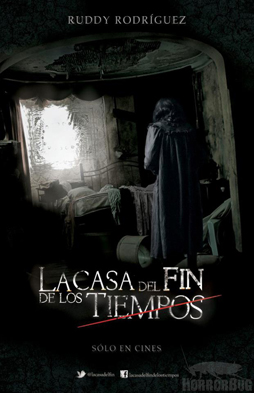 Asked where the idea of the film came from, and if there was anything inherently scary about technology, writer Nelson Greaves said it came from an idea producer Timur Bekmambetov had had for years. Dramas of modern life, he said, don’t take place where they used to, in the real world, but on computers. It was important for them to tell a story on the computer screen, and the particular story came together when the filmmakers realised it was a horror story, revolving specifically around the horrors of modern bullying. Gabriadze observed that any genre of story could be told in the same way. In response to another question, Greaves noted that it was also something nobody had done before, and therefore there was an aspect of gratifying curiosity in doing it.
Asked where the idea of the film came from, and if there was anything inherently scary about technology, writer Nelson Greaves said it came from an idea producer Timur Bekmambetov had had for years. Dramas of modern life, he said, don’t take place where they used to, in the real world, but on computers. It was important for them to tell a story on the computer screen, and the particular story came together when the filmmakers realised it was a horror story, revolving specifically around the horrors of modern bullying. Gabriadze observed that any genre of story could be told in the same way. In response to another question, Greaves noted that it was also something nobody had done before, and therefore there was an aspect of gratifying curiosity in doing it.
There was some discussion of how long the movie took to put together and how much it cost. It seems to have been a year and a half, mostly in editing. There were also extensive rehearsals, and it took a lot of time to figure out how to do things: “It was research,” said Bekmambetov. Asked about how they got rights from companies like Google and Facebook to depict their web sites in the film, Greaves stated that this was covered by the fair use provision in copyright law. The film wouldn’t be authentic without the actual sites, he felt. Asked if further or similar films were planned, Bekmambetov said that people with ideas should get in touch with them through their Facebook page; they could help or support similar ideas.
The next day I was back at the De Sève at 5:20 for The House at the End of Time. Directed and written by Alejandro Hidalgo, it begins with aftermath. A woman, Dulce (Ruddy Rodriguez) slowly wakes up in her home after being knocked unconscious. She stumbles around, is attacked again by a dying man, and then watches her son be pulled away through a dark doorway. She survives, but is arrested for the murder of her husband and child. At which point the film leaps forward thirty years, when, allowed to serve out her prison sentence in her own house, she returns to the scene of the bizarre attacks. They took place in 1981; it is now 2011. And strange hints and mysterious happenings suggest some new terror may be about to happen.
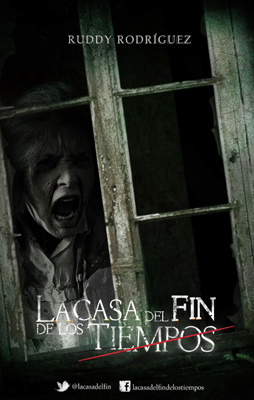 The film unfolds through flashbacks, advancing its story in two separate time periods. This works well, keeping the tension up while exploring odd narrative angles, such as the priest (Guillermo Garcia) who tries to help Dulce in 2011 or presenting the stories of her two sons, Leopoldo (Rosmel Bustamante) and Rodrigo (Hector Mercado) in 1981. It largely takes place within the house where Dulce’s kept prisoner, but not entirely. Notably, there are scenes in 2011 where the priest learns about the mysterious involvement of English Masons in the building of Dulce’s house, and scenes in 1981 where Dulce’s kids play with their friends. And there’s a wonderful scene, also in the 1981 timeline, where Dulce goes to the house of a fortuneteller, a woman who can see beyond time.
The film unfolds through flashbacks, advancing its story in two separate time periods. This works well, keeping the tension up while exploring odd narrative angles, such as the priest (Guillermo Garcia) who tries to help Dulce in 2011 or presenting the stories of her two sons, Leopoldo (Rosmel Bustamante) and Rodrigo (Hector Mercado) in 1981. It largely takes place within the house where Dulce’s kept prisoner, but not entirely. Notably, there are scenes in 2011 where the priest learns about the mysterious involvement of English Masons in the building of Dulce’s house, and scenes in 1981 where Dulce’s kids play with their friends. And there’s a wonderful scene, also in the 1981 timeline, where Dulce goes to the house of a fortuneteller, a woman who can see beyond time.
That scene of ritual strangeness feels key. Partly because at the end of the movie, when much else has become clear and things harmonise neatly with each other, the weird things we see in the fortuneteller’s house remain defiantly inexplicable. And partly because the scene seems to establish what genre this story really is. The movie begins with an obtrusive soundtrack and blatant jump-scares, but it isn’t really a horror movie. It’s a magic realist movie that uses horror-movie chrome.
There’s horror iconography at work here, and horror-film shot selections, and horror-film pacing. But the horror isn’t where we think it might be. The strange and threatening events become clear, and all feed back onto themselves in an elegant way, and by the end we realise what has been happening and where the threat lies (it is of course quite possible to see things coming well before the end, but the movie works well even so, as you see the symmetry of its construction work itself out naturally). The atmosphere changes in retrospect. The horrific events stand revealed as tragic, or merely sad. We’ve been watching a family drama given a dreamlike feel by the incursion of the fantastic. There’s a marriage of realism and the fantastic that seems to me to be characteristic of magic realism.
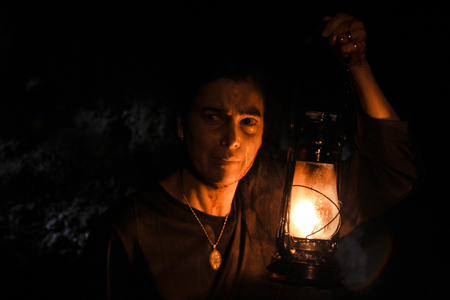 This wouldn’t work if it weren’t for the strong character work in the writing, acting, and directing. There’s a wonderful understated argument in 1981 when Dulce’s husband Juan José says of better times that “I miss those days.” Dulce answers “I miss those days that never came.” And Juan José leaves their bedroom. In context it’s wounding and tragic, speaking of the loss of hope and time and youth and dreams. Of two people who’ve lost faith in each other. This is a movie about times and family, about losing and gaining the days of one’s life. It’s subtle and tightly-constructed and well-acted, and I recommend it highly.
This wouldn’t work if it weren’t for the strong character work in the writing, acting, and directing. There’s a wonderful understated argument in 1981 when Dulce’s husband Juan José says of better times that “I miss those days.” Dulce answers “I miss those days that never came.” And Juan José leaves their bedroom. In context it’s wounding and tragic, speaking of the loss of hope and time and youth and dreams. Of two people who’ve lost faith in each other. This is a movie about times and family, about losing and gaining the days of one’s life. It’s subtle and tightly-constructed and well-acted, and I recommend it highly.
At 9:45 I was once again in the De Sève Theatre for the Canadian premiere of Time Lapse, directed by Bradley King and written by King with B.P. Cooper. It takes place at a residential development, where the custodian, Finn (Matt O’Leary), is a blocked painter living with his longtime girlfriend Callie (Danielle Panabaker) and their friend Jasper (George Finn). Across from them lives a strange old man, an inventor named Mr. Bezzeredes. Finn, Callie, and Jasper find that Bezzeredes has died, and then find a strange device in Bezzeredes’ room, a camera pointing at their own living room window. And then they find the secret of the device: every day at 8 PM it takes a picture of 24 hours in the future. They can see their window — tomorrow. They decide to take advantage of this, writing down the results of horse races on pieces of paper and taping them up on the window-glass. But Jasper’s bookie gets suspicious of their run of good luck. And one of Bezzeredes’ colleagues comes snooping around. And the stresses the device brings to the friends’ relationship threaten to reveal secrets that could tear them apart.
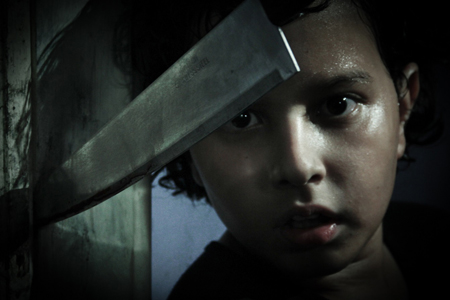 Conceptually, Time Lapse is a fine idea. It’s nicely shot, managing to give a varied sense of the same basic locations. The acting’s fine. But the script, which needed to be razor-sharp, has some issues. The character interactions are a bit too obvious, and the way they develop too blunt. Jasper’s got a drug habit which escalates over the course of the film, but there’s a lack of specificity about what drugs he’s doing; you just get the sense of ‘evil pills’ with no feeling for how it plays out in the continuity of his character, an easy explanation for the things he does. Finn’s overjoyed by the discovery of the camera, because the future photos show him what to paint, letting him break through his block; but you wonder what kind of artist is satisfied with tracing out an image already composed for him. The characters all leap to a conclusion about the effects of meddling with time which seems improbable; you literally wonder how stupid they’re meant to be.
Conceptually, Time Lapse is a fine idea. It’s nicely shot, managing to give a varied sense of the same basic locations. The acting’s fine. But the script, which needed to be razor-sharp, has some issues. The character interactions are a bit too obvious, and the way they develop too blunt. Jasper’s got a drug habit which escalates over the course of the film, but there’s a lack of specificity about what drugs he’s doing; you just get the sense of ‘evil pills’ with no feeling for how it plays out in the continuity of his character, an easy explanation for the things he does. Finn’s overjoyed by the discovery of the camera, because the future photos show him what to paint, letting him break through his block; but you wonder what kind of artist is satisfied with tracing out an image already composed for him. The characters all leap to a conclusion about the effects of meddling with time which seems improbable; you literally wonder how stupid they’re meant to be.
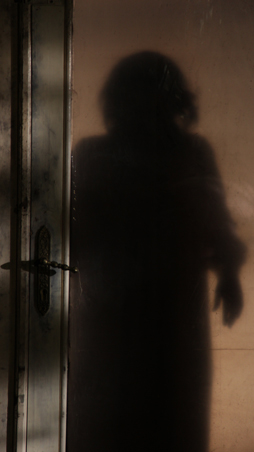 Jasper’s bookie finds out about the camera for a reason that goes beyond unlikely. Plot difficulties accrue as the film’s body count rises; people die, and nobody comes looking for them. Jasper argues that the future-photos will always prove he and his friends are safe so long as they all appear in them, but what does he think will happen when they inevitably go missing, or turn up wounded? Near the end a photo contains elements that ought to raise warning flags, but nobody seems to notice it.
Jasper’s bookie finds out about the camera for a reason that goes beyond unlikely. Plot difficulties accrue as the film’s body count rises; people die, and nobody comes looking for them. Jasper argues that the future-photos will always prove he and his friends are safe so long as they all appear in them, but what does he think will happen when they inevitably go missing, or turn up wounded? Near the end a photo contains elements that ought to raise warning flags, but nobody seems to notice it.
But the movie does build nicely to a series of twists at the end. They bring an underused character to the fore, and throw new light on a few things. But I’m not sure in the end that the film really says anything particularly memorable. It’s not too bad, in a low-level Twilight Zone-meets-Hitchcock way, but it doesn’t develop any real power.
A question-and-answer session followed with King and Cooper. They talked about wanting to do something different with the film as a time travel movie. It took them some time to develop, working on the plot with notecards for two weeks followed by two weeks to produce a script. King acknowledged Cooper’s work in keeping things straight in the script. An audience member said that the pacing was strong, and asked about their inspiration; King said that they’d written a lot of thrillers and had the three-act structure down tightly. But they also broke films that seemed particularly effective to them down into notes to get a sense of their pacing and work out the plot points and moments as needed. King also said that in the case of Time Lapse the film’s editor was given free reign. Cooper added that the editor did a two-and-a-half-hour cut of the film that was the movie as it had been originally scripted, after which they allowed him to cut as he liked. In terms of what was left on the cutting-room floor, King reflected: “Well, we cut Godzilla. He’s out.”
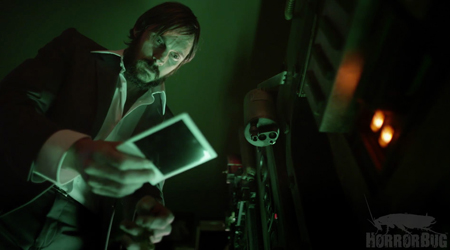 King also acknowledged something leaving out something particularly painful for him as a fan of Raiders of the Lost Ark: Mr. Bezzaredes. John Rhys-Davies was cast as Bezzaredes, who was originally going to appear in flashback. Those scenes had to be cut, as they were redundant and slowed the movie down; apparently the film “tested better” after they were deleted. Asked about the cinematography, King credited the film’s cinematographer (Jonathan Wenstrup). He remembered talking with him about shooting in one location, and how to change the lighting for different effects. King remembered discussions about whether to use the particular shade of green light associated with the camera, whether it was too cliché and too reminiscent of Aliens.
King also acknowledged something leaving out something particularly painful for him as a fan of Raiders of the Lost Ark: Mr. Bezzaredes. John Rhys-Davies was cast as Bezzaredes, who was originally going to appear in flashback. Those scenes had to be cut, as they were redundant and slowed the movie down; apparently the film “tested better” after they were deleted. Asked about the cinematography, King credited the film’s cinematographer (Jonathan Wenstrup). He remembered talking with him about shooting in one location, and how to change the lighting for different effects. King remembered discussions about whether to use the particular shade of green light associated with the camera, whether it was too cliché and too reminiscent of Aliens.
In response to further questions King spoke about the nature of temporal inevitability. He felt it would be unsatisfactory if the characters were able to change things. He felt the movie’s theme was an encouragement to live in the moment. On another note, he spoke about working with a concept artist he came across on Deviantart, how a specific painting led to him contacting the artist to put together designs for the massive camera. King wanted an analog-looking device, and the machine in the film was only the third design sketched. Cooper spoke about hiring one of the actors, the man who played Jasper’s bookie; in the film he delivers an intense performance as an ex-leg-breaker, and Cooper recalled how everyone was slightly afraid of him during shooting. When he came in much later to record some lines for post-production, he looked and sounded entirely different, and that was when they found out he’d been staying in character all during filming to ensure he kept the part. Cooper and King also talked about whether they were keeping track of exactly what drugs Jasper was taking over the course of the film; King said it was something he was very aware of, and discussed with the actor.
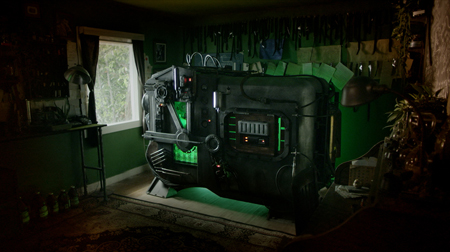 They discussed the shooting schedule; the movie took 27 days to shoot, which King said was a testament to Cooper’s organizational skills and problem-solving ability. There are discussions currently underway for a TV show related to the film; they want to do the show, but also want to do different films. For the moment, the prop of the camera is still in storage, “still kicking out photos,” as King said.
They discussed the shooting schedule; the movie took 27 days to shoot, which King said was a testament to Cooper’s organizational skills and problem-solving ability. There are discussions currently underway for a TV show related to the film; they want to do the show, but also want to do different films. For the moment, the prop of the camera is still in storage, “still kicking out photos,” as King said.
There’s an interest for me in hearing creators talk about their projects, even when I didn’t much care for the result. Almost any given creative endeavour takes some amount of commitment, which means the investment of some amount of passion. King and Cooper clearly knew what they wanted to do, and in large part succeeded. The mechanics of their time-bending plot worked nicely, even when all the twists were revealed; and it is difficult, I think, to sell a major plot twist, to make it feel as though it explains more things than it seems to contradict. That’s something they do pull off, a couple of times. I didn’t feel that the plausibility of the scenario held, or that the personalities of the characters were convincing. But if these things hold the film back from total success for me, I have to admit they don’t entirely sink it. It’s the sort of movie that I suspect will work depending on the expectations you go in with. Take it for what it is, and it does its job well enough.
(You can find links to all my Fantasia diaries here.)
Matthew David Surridge is the author of “The Word of Azrael,” from Black Gate 14. His ongoing web serial is The Fell Gard Codices. You can find him on Facebook, or follow his Twitter account, Fell_Gard.